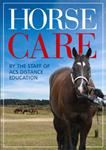Many breeds of horses can be kept at grass all year round, withstanding the worst weather conditions, if they are cared for adequately. If shelter, additional feeding, rugs (especially in cold climates) are used, drainage of the paddock or field is good, water supply is kept fresh and unfrozen, and grooming is carried out – then a horse being kept at grass full time is an option. That said some lighter coated horses are best kept stabled at night during the winter months in cold climates.
Steep sloping paddocks, hills and uneven field surfaces are not at all ideal – some hardy breeds will carry on with no real problem in those pastures, however certain larger breeds or young animals, may develop back or hock strains if permanently out in steep paddocks. In addition to this, horses are selective feeders – this can present issues. Secondly, ‘roughs’ and ‘camps’ develop in areas where horses urinate and excrete faeces, where ‘lawns’ (areas of short grasses) develop in grazed areas.
Horses kept solely at grass should be checked at least once a day and ideally twice a day to ensure that they are safe, healthy and have an adequate supply of food and water. In the winter months it is important to ensure that the water supply in the field does not freeze over and that any rugs that the horse is wearing are comfortable and in good condition.
It is not always practical to keep a horse solely at grass depending on the individual horses needs and the type of work the horse is required to do. A horse may need to be kept stabled, either periodically or on a more permanent basis, due to the facilities available, quality and availability of grazing, injury or illness, for convenience or for a variety of other reasons.
Horses that are kept confined in a stable for excessively long periods of time can become bored and consequently may become difficult to handle or may develop unwanted ‘stereotypical’ behaviours.
To prevent this happening, it is advisable to allow a horse access to pasture for a number of hours each day. The horse will then have the opportunity to fulfill its natural behaviours of constantly moving around and eating small amounts of food regularly, and socializing with other horses.
If turn out is not available then exercise in hand or under saddle is vitally important. Splitting up exercise periods to two or more sessions in a day is better than just one longer session. This will greatly help to prevent boredom and instances of challenging behavior occurring in the stabled horse
 Equine Books Click here for our Mail Order Bookshop
Equine Books Click here for our Mail Order Bookshop
Equine Distance Education Courses from ACS Distance Education
(click on a course below to enrol or scroll down for detailed outline of Horse Care I)
orse Care I
Learn to manage the daily requirements of a horse at grass. The course aims to develop:
-The ability to handle horses using a range of different procedures
-Skills to evaluate a horses conformation
-An understanding of diet
-Knowledge of grooming procedures
-An ability to develop appropriate management procedures for a specific situation.
-Knowledge of commercial opportunities in the horse industry, including how to buy and sell horses.
Horse Care II
This course develops skills in the management of horses in a wide range of situations, including in stables.
Horse Care III
Develops skills in the management of horses in a variety of situations